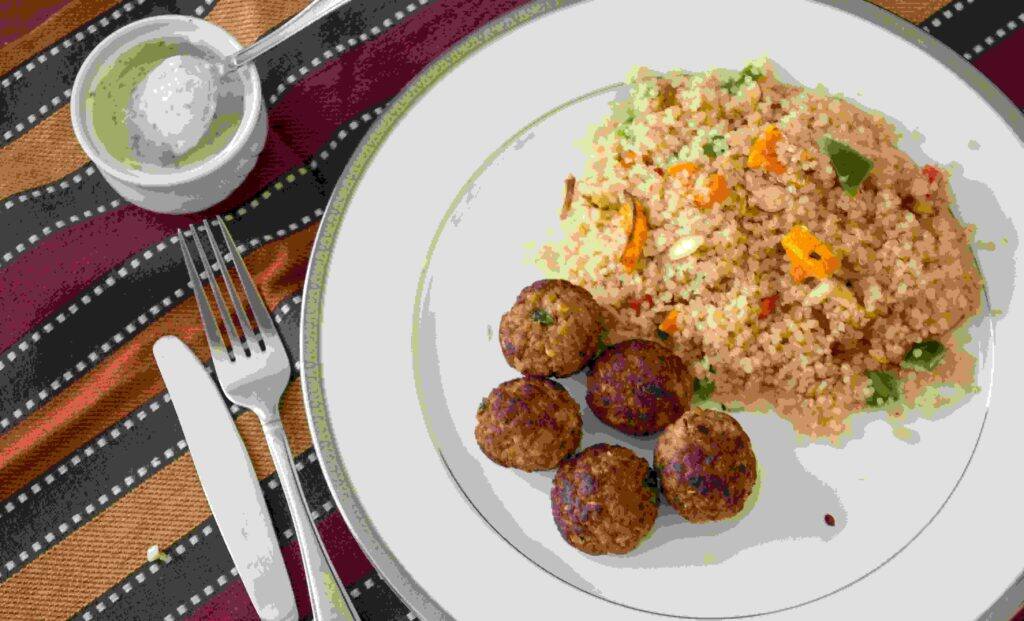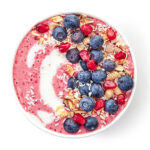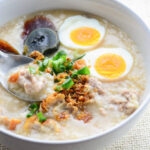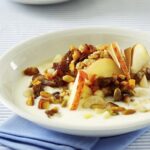Soya chunks and quinoa pilaf is a nutritious and flavorful dish that combines the goodness of protein-rich soya chunks with the high-fiber, gluten-free quinoa. This pilaf is not only delicious but also provides a complete amino acid profile, making it an excellent choice for vegetarians and vegans seeking to increase their protein intake. With its blend of spices and vegetables, this dish offers a satisfying and wholesome meal suitable for lunch or dinner.
| Ingredients | |
| 1 | 1 cup quinoa, rinsed |
| 2 | 1 cup soya chunks |
| 3 | 2 tablespoons olive oil |
| 4 | 1 onion, finely chopped |
| 5 | 2 cloves garlic, minced |
| 6 | 1 teaspoon cumin seeds |
| 7 | 1 teaspoon coriander powder |
| 8 | 1/2 teaspoon turmeric powder |
| 9 | 1/2 teaspoon garam masala |
| 10 | Salt to taste |
| 11 | 2 cups water or vegetable broth |
| 12 | 1 carrot, diced |
| 13 | 1 bell pepper, diced |
| 14 | 1 cup green peas |
| 15 | Fresh coriander leaves for garnish |
| 16 | Lemon wedges for serving |
Step-by-step cooking instruction of Soya Chunks and Quinoa Pilaf:
Step-1 Prepare the soya chunks: Begin by soaking the soya chunks in hot water for about 15-20 minutes or until they become soft. Once softened, drain the water and squeeze out excess moisture from the soya chunks. Set aside.
Step-2 Cook the quinoa: In a large saucepan, heat 1 tablespoon of olive oil over medium heat. When the rinsed quinoa begins to produce a nutty aroma, add it and toast it for two to three minutes, stirring now and again.
Step-3 Sauté onions and spices: Push the quinoa to the side of the saucepan and add the remaining tablespoon of olive oil. Add the chopped onions and minced garlic, sautéing until the onions turn translucent. Then add the cumin seeds, coriander powder, turmeric powder, and garam masala. Stir well to coat the onions and quinoa with the spices.
Step-4 Add water and vegetables: Pour in the water or vegetable broth and add the diced carrot, bell pepper, green peas, and soaked soya chunks. Season with salt according to taste. Bring the mixture to a boil, then reduce the heat to low, cover the saucepan, and let it simmer for about 15-20 minutes or until the quinoa is cooked and the vegetables are tender.
Step-5 Fluff and garnish: Once the quinoa is cooked and the liquid is absorbed, remove the saucepan from heat. Fluff the pilaf with a fork to separate the grains and evenly distribute the vegetables and soya chunks. Garnish with fresh coriander leaves.
Step-6 Serve: Serve the soya chunks and quinoa pilaf hot, accompanied by lemon wedges for squeezing over the pilaf for added freshness and flavor.
Nutritional values of Soya Chunks and Quinoa Pilaf:
Here’s a breakdown of the approximate nutritional values for a serving of soya chunks and quinoa pilaf:
| 1 | Calories: Around 300-350 calories per serving (varies based on portion size and specific ingredients). |
| 2 | Protein: Soya chunks are a rich source of protein, providing about 10-12 grams of protein per 1/4 cup serving, while quinoa offers approximately 8 grams of protein per cooked cup. Together, they contribute significantly to the protein content of the pilaf, making it an excellent plant-based protein source. |
| 3 | Carbohydrates: Quinoa is a good source of complex carbohydrates, providing around 30 grams per cooked cup. Soya chunks also contain carbohydrates but in smaller amounts compared to quinoa. |
| 4 | Fiber: Quinoa is high in dietary fiber, with approximately 5 grams per cooked cup, which aids in digestion and helps promote satiety. The addition of vegetables further increases the fiber content of the dish. |
| 5 | Fat: Both soya chunks and quinoa contain small amounts of fat. The use of olive oil in cooking also contributes to the overall fat content of the dish. |
| 6 | Micronutrients: Soya chunks are rich in essential nutrients such as iron, calcium, magnesium, and phosphorus. Quinoa is also a good source of several vitamins and minerals, including folate, manganese, phosphorus, and magnesium. Additionally, the vegetables used in the pilaf provide a variety of vitamins and minerals, enhancing its nutritional profile. |
| 7 | Sodium: The sodium content of the dish can vary depending on the amount of salt added during cooking. It’s advisable to moderate salt intake for those with dietary restrictions or health concerns related to sodium consumption. |
Background History of Soya Chunks and Quinoa Pilaf
The history of soya chunks and quinoa pilaf originates from the culinary evolution of plant-based diets and the exploration of diverse cuisines around the world. Here’s a brief background history of the key ingredients and their integration into pilaf-style dishes:
Soya Chunks:
Origins: Soya chunks, also known as textured vegetable protein (TVP) or soy meat, have their origins in East Asia, particularly in countries like China and Japan where soybeans have been cultivated for thousands of years.
Development: The process of creating textured vegetable protein from soy flour or concentrate was developed in the mid-20th century as a means to provide a nutritious and versatile meat alternative.
Popularity: Soya chunks gained popularity in vegetarian and vegan diets due to their high protein content and meat-like texture. They became widely available in various forms, including dried chunks or granules, and are used in a variety of cuisines worldwide.
Quinoa:
Ancient Grain: Quinoa is an ancient grain native to the Andean region of South America, where it has been cultivated for over 5,000 years by indigenous peoples such as the Incas.
Nutritional Value: Quinoa gained international recognition in recent decades for its exceptional nutritional profile, being one of the few plant foods that contain all nine essential amino acids, making it a complete protein source.
Culinary Adoption: As interest in gluten-free, whole grain alternatives grew, quinoa gained popularity beyond its native regions and became a staple ingredient in health-conscious diets around the world.
Versatility: Quinoa’s versatility in cooking, its nutty flavor, and fluffy texture made it a popular choice for various dishes, including pilafs, salads, soups, and breakfast bowls.
Soya Chunks and Quinoa Pilaf:
Integration: The combination of soya chunks and quinoa in a pilaf-style dish represents the fusion of diverse culinary traditions and modern dietary preferences.
Nutritional Synergy: Soya chunks and quinoa complement each other nutritionally, with soya providing a high-quality plant-based protein source and quinoa offering complex carbohydrates, fiber, and essential micronutrients.
Culinary Creativity: The pilaf format allows for the incorporation of various vegetables, herbs, and spices, enhancing the flavor and nutritional content of the dish.
Global Appeal: Soya chunks and quinoa pilaf exemplify the global trend towards healthier, plant-centric eating habits, appealing to vegetarians, vegans, and health-conscious individuals seeking flavorful and nutritious meal options.
In conclusion, the history of soya chunks and quinoa pilaf reflects the intersection of culinary traditions, nutritional awareness, and contemporary dietary trends, resulting in a delicious and wholesome dish enjoyed by people around the world.
| Advantages of Soya Chunks and Quinoa Pilaf | |
| 1 | High Protein Content: Soya chunks are an excellent source of plant-based protein, while quinoa also provides a good amount of protein. This makes the pilaf a filling and satisfying meal, especially for vegetarians and vegans. |
| 2 | Complete Amino Acid Profile: Both soya chunks and quinoa contain all nine essential amino acids, making them a complete protein source when combined. This is beneficial for muscle repair, growth, and overall health. |
| 3 | Rich in Fiber: Quinoa is high in dietary fiber, which aids in digestion, promotes satiety, and helps regulate blood sugar levels. The addition of vegetables further increases the fiber content of the pilaf, supporting digestive health. |
| 4 | Nutrient-Dense: Soya chunks are rich in essential nutrients such as iron, calcium, and B vitamins, while quinoa provides vitamins and minerals like magnesium, manganese, and phosphorus. This pilaf offers a wide array of micronutrients necessary for overall well-being. |
| 5 | Gluten-Free and Low-Glycemic: Quinoa is naturally gluten-free and has a low glycemic index, making it suitable for individuals with gluten sensitivities or those monitoring their blood sugar levels. |
| Versatile and Customizable: Soya chunks and quinoa pilaf can be customized with various vegetables, herbs, and spices to suit personal preferences and dietary needs. It can be adapted to accommodate different flavor profiles and cuisines. | |
| 7 | Quick and Easy to Prepare: Soya chunks and quinoa pilaf can be prepared relatively quickly, making it a convenient option for busy weeknight dinners or meal prep. |
| Disadvantages of Soya Chunks and Quinoa Pilaf | |
| 1 | Potential Allergies: Some individuals may have allergies to soy products, leading to adverse reactions such as digestive issues or skin rashes. It’s important to be cautious if you have a soy allergy. |
| 2 | Flatulence: Soya chunks, especially if not cooked properly or if consumed in large quantities, may cause flatulence or digestive discomfort in some individuals due to their high fiber content. |
| 3 | Antinutrients: Quinoa contains antinutrients such as saponins and phytic acid, which can interfere with nutrient absorption in the body. While rinsing quinoa before cooking can reduce their levels, some may still be present. |
| 4 | Caloric Density: While nutritious, soya chunks and quinoa pilaf can be calorie-dense, especially if large portions or excessive amounts of oil are used in cooking. Portion sizes are important to consider for those who are watching their calorie consumption. |
| 5 | Price: Soya chunks and quinoa may be more expensive compared to other grains and protein sources, which could be a deterrent for individuals on a tight budget. |
| 6 | Cultural Acceptance: While widely accepted in many parts of the world, soya chunks and quinoa may not be as familiar or readily available in certain regions, limiting accessibility for some individuals. |
| 7 | Texture and Flavor: Some people may find the texture of soya chunks or the nutty flavor of quinoa to be unfamiliar or less palatable, particularly if they are accustomed to traditional meat or grain dishes. |
Compare with Similar meal of Soya Chunks and Quinoa Pilaf:
There are several meals similar to soya chunks and quinoa pilaf that incorporate similar ingredients or share common characteristics. Here are a few examples:
| 1 | Quinoa Salad with Chickpeas and Roasted Vegetables: This dish features cooked quinoa mixed with chickpeas, roasted vegetables (such as bell peppers, zucchini, and cherry tomatoes), fresh herbs (like parsley or basil), and a tangy dressing made with olive oil, lemon juice, and garlic. It offers a flavorful and nutritious meal packed with protein, fiber, and vitamins. |
| 2 | Soya Chunk Curry with Brown Rice: Similar to quinoa pilaf, this dish involves cooking soya chunks in a flavorful curry sauce along with onions, tomatoes, garlic, and spices like cumin, coriander, and turmeric. Serve it over cooked brown rice for a hearty and satisfying meal that’s rich in protein and fiber. |
| 3 | Quinoa and Black Bean Stuffed Peppers: Halved bell peppers are filled with a mixture of cooked quinoa, black beans, corn, diced tomatoes, onions, and spices. The stuffed peppers are then baked until tender. This dish offers a colorful and nutritious option that’s high in protein, fiber, and essential nutrients. |
| 4 | Soya Chunk Stir-Fry with Vegetables and Noodles: Soya chunks are stir-fried with a medley of vegetables such as bell peppers, broccoli, carrots, and snap peas, along with garlic, ginger, and soy sauce. Serve it over cooked noodles (such as whole wheat or rice noodles) for a quick and flavorful meal that’s packed with protein and vegetables. |
| 5 | Quinoa and Lentil Soup: This hearty soup combines cooked quinoa, lentils, diced vegetables (such as carrots, celery, and onions), vegetable broth, tomatoes, herbs, and spices. It’s a comforting and nutritious option that’s high in protein, fiber, and essential vitamins and minerals. |
| 6 | Soya Chunk and Vegetable Biryani: Biryani is a fragrant rice dish made with layers of spiced rice, vegetables, and protein. In this variation, cooked soya chunks are layered with basmati rice, caramelized onions, mixed vegetables, and aromatic spices like cardamom, cinnamon, and saffron. The dish is then cooked until the flavors meld together, creating a delicious and satisfying meal. |
Mostly questions asked about Soya Chunks and Quinoa Pilaf
1: What are soya chunks?
A: Soya chunks, also known as textured vegetable protein (TVP), are a meat substitute made from defatted soy flour. They are processed into granules or chunks and are rich in protein, making them popular among vegetarians and vegans.
2: What is quinoa?
A: Quinoa is an ancient grain native to the Andean region of South America. It is prized for its high protein content and unique nutritional profile, as it contains all nine essential amino acids. Quinoa is a gluten-free grain that may be cooked and added to soups, salads, and pilafs.
3: How do you cook soya chunks?
A: Soya chunks are typically soaked in hot water for about 15-20 minutes to rehydrate them. Once softened, they can be squeezed to remove excess water and then added to dishes such as curries, stir-fries, or pilafs where they absorb flavors well during cooking.
4: Is quinoa easy to cook?
A: Yes, quinoa is relatively easy to cook. It is cooked similarly to rice, using a ratio of water to quinoa (usually 2:1) and simmering until the water is absorbed and the quinoa is tender, usually around 15-20 minutes.
5: What are the nutritional benefits of soya chunks and quinoa pilaf?
A: Soya chunks and quinoa pilaf is a nutritious dish that provides a complete protein source, along with fiber, vitamins, and minerals. Soya chunks are high in protein, while quinoa offers a range of nutrients including iron, magnesium, and B vitamins.
6: Are soya chunks and quinoa pilaf suitable for vegetarians and vegans?
A: Yes, soya chunks and quinoa pilaf are suitable for both vegetarians and vegans as they are made from plant-based ingredients. They provide a good source of protein without the need for animal products.
7: Can I customize the ingredients in soya chunks and quinoa pilaf?
A: Yes, soya chunks and quinoa pilaf can be customized according to personal preferences. You can add various vegetables, spices, and herbs to tailor the dish to your taste.
8: Are soya chunks and quinoa pilaf gluten-free?
A: Yes, both soya chunks and quinoa are gluten-free, making them suitable for individuals with gluten sensitivities or those following a gluten-free diet.
9: How can I add more flavor to soya chunks and quinoa pilaf?
A: You can enhance the flavor of soya chunks and quinoa pilaf by using aromatic spices like cumin, coriander, turmeric, and garam masala. Additionally, adding fresh herbs, garlic, onions, and lemon juice can impart more depth of flavor to the dish.
10: Is soya chunks and quinoa pilaf suitable for meal prep?
A: Yes, soya chunks and quinoa pilaf can be prepared in advance and stored in the refrigerator for several days. It reheats well and can be enjoyed as a convenient and nutritious meal option throughout the week.







